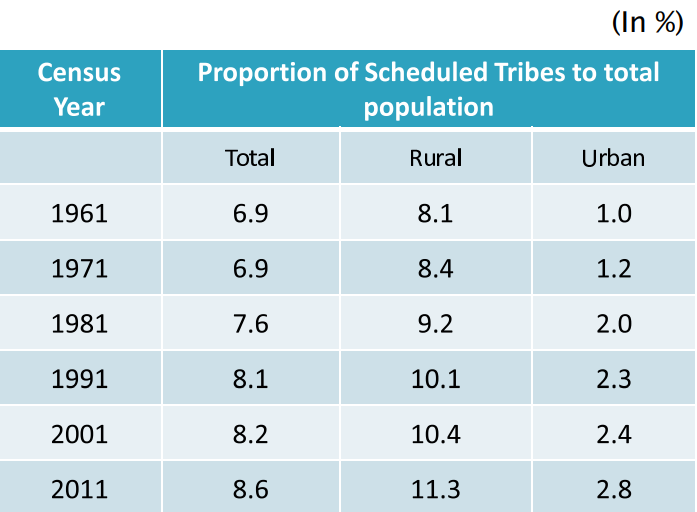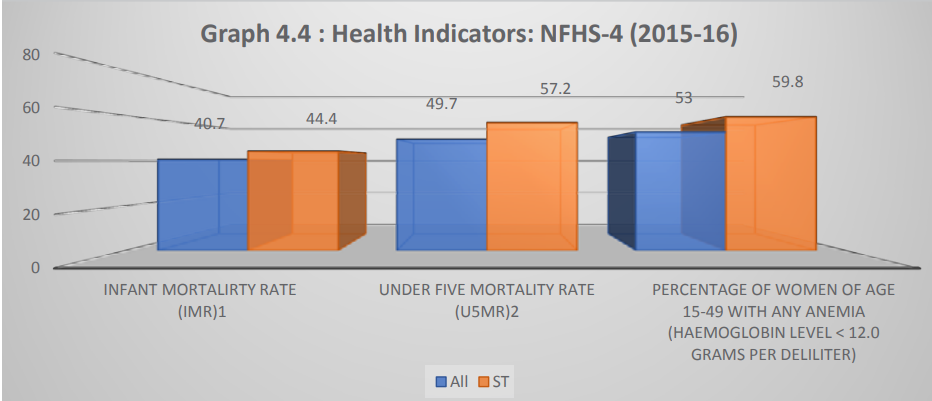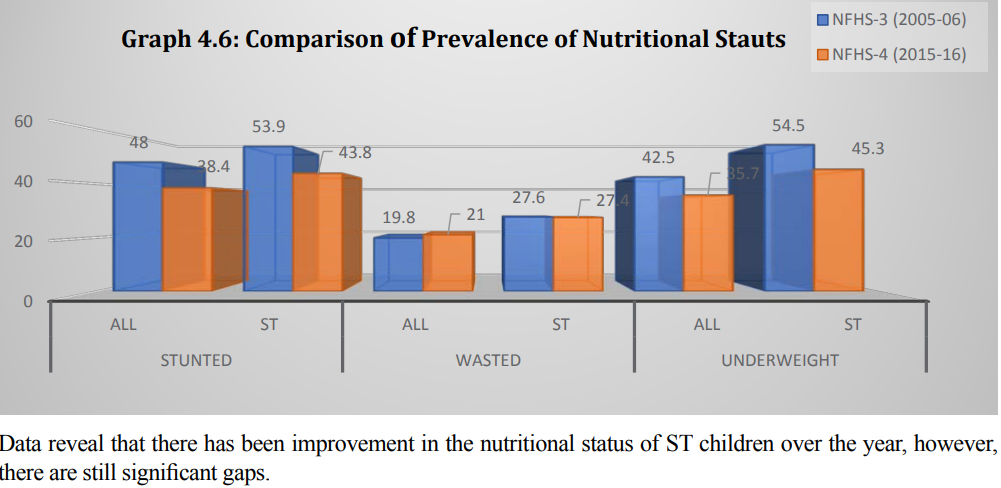Tribal Development
2022 DEC 9
Mains >
Social justice > Welfare Schemes > Tribal affairs
IN NEWS:
- Recently, the Tribal Development Report 2022 was launched by the Bharat Rural Livelihood Foundation (BRLF), which claims to be the first of its kind since 1947.
MORE ON NEWS:
- The report focuses on the status of tribal communities at an all-India level and central India in particular, concerning livelihoods, agriculture, natural resources, economy, migration, governance, human development, gender, health, education, art, and culture.
- The report stated that indigenous communities of India have been pushed farther away from alluvial plains and fertile river basins into the harshest ecological regions of the country like hills, forests, and drylands.
- As per the report, of the 257 Scheduled Tribe districts, 230 (90 per cent) are either forested or hilly or dry.
|
Bharat Rural Livelihoods Foundation (BRLF) was set up by the Government of India as an independent society under the Ministry of Rural Development, to scale up civil society action in partnership with the central and state governments. The Union Cabinet decided to form Bharat Rural Livelihoods Foundation (BRLF) through a cabinet decision on 3rd September 2013 to ensure better implementation and outreach of the government schemes and programmes in partnership with civil society organizations.
|
TRIBES OR ADIVASIS:
- Tribal groups or Adivasis are considered to be the earliest inhabitants of India. The term Adivasi is commonly translated as ‘indigenous people’ or ‘original inhabitants.
- Adivasis are not a homogeneous group; there are over 200 distinct peoples speaking more than 100 languages, and varying greatly in ethnicity and culture. However, there are similarities in their way of life and generally perceived oppressed position within Indian society.
- The government recognizes most Adivasis under the Constitutional term “Scheduled Tribes” derived from a schedule in the Constitution Order of 1950.
TRIBES & INDIAN CONSTITUTION
- The Constitution of India uses the term Scheduled Tribes or “Anusuchit Janjati” to describe tribes.
- Article 342 says that only those communities who have been declared as such by the President through an initial public notification or through a subsequent amending Act of Parliament will be considered to be scheduled tribes.
CRITERIA FOR IDENTIFICATION OF SCHEDULED TRIBES:
- Identification of schedule tribes itself was a problem and a set of guidelines was first laid down by the Lokur Committee.
- The criteria followed for specifying a community as ST are:
- Indications of primitive traits;
- Distinctive culture;
- Shyness of contact with the community at large;
- Geographical isolation
- Backwardness
- These criteria are not spelt out in the Constitution but have become well-established.
SCHEDULED TRIBES IN INDIA:
- According to Census 2011, the population of scheduled tribes in India is 10.45 crores. It constitutes 8.6% of the total population of India.
- The total number of Scheduled Tribes notified across 30 States/UT is 705.
---------------------
- Development Profile of Scheduled Tribes (Annual Report 2020-21, MoTA)
- Literacy Rate:
- 59% in 2011 (Males→ 68.5% ; Females→ 49.4%)
- Literacy rate for the total population was 73% in 2011.
- There is a gap of 14 % points in literacy rate of STs as compared to the all India literacy rate.
- Health Indicators: (NFHS-4, 2015-16)

-
-
- Nutritional Status of Children under 5 years:

-
- Poverty Estimates:
- ST people living below the poverty line in 2011-12 were 45.3% in the rural areas and 24.1% in the urban areas as compared to 25.7% persons in rural areas and 13.7% persons in urban areas below poverty line for all population.
GOVERNMENT INITIATIVES FOR TRIBAL DEVELOPMENT:
- Eklavya Model Residential School (EMRS): It is a central sector scheme introduced in the year 1997-98 to provide quality education to Scheduled Tribes (ST) students (Class 6th to 12th) in remote areas through residential schools. As on date, 684 schools have been sanctioned by the Ministry of Tribal Affairs, out of which 378 are reported to be functional.
- Grants under Article 275(1) of the Constitution of India: Under this scheme, funds are released to States to enable them to meet the cost of such schemes of development as may be undertaken by the State for the purpose of promoting welfare of Scheduled Tribes in that State or raising the level of administration of Scheduled Areas therein to that of the administration of the rest of the areas of that State.
- Pradhan Mantri Adi Adarsh Gram Yojna (PMAAGY): ‘Pradhan Mantri Adi Adarsh Gram Yojna (PMAAGY)’, aims at providing Basic Infrastructure in 36428 villages with significant tribal population having at least 50% tribal population and 500 STs in convergence with Central STC and State TSP funds.
- National Fellowship and Scholarship for Higher Education of ST Students: The scheme provides financial assistance or pursuing MPhil and PhD in Universities and for perusing graduate and post graduate courses in top 246 Institutes like IIT/AIIMS etc .
- National Overseas Scholarship (NOS) to the ST Students for Studies Abroad: Under the Scheme, financial assistance is provided to 20 ST students every year for pursuing higher studies abroad.
- Aid to Voluntary Organizations working for the welfare of Scheduled Tribes: Ministry of Tribal Affairs has been funding Voluntary Organizations (VOs) including Non-Governmental Voluntary Organizations (NGOs) working in tribal Hilly, remote and border areas for projects in Education, Health and Livelihood.
- Venture Capital Fund (VCF) for Scheduled Tribes: From the year 2021-22, the scheme of ‘Venture Capital Fund for Scheduled Tribes’ (VCF-ST) has been taken up by the Ministry of Tribal Affairs with a corpus fund of ?50.00 crore for a period of five years for promoting entrepreneurship/start-up projects by ST youth.
- Pradhan Mantri Jan Jatiya Vikas Mission (PMJVM): This scheme has been conceptualized with the merger of two schemes i.e. (i) ‘Mechanism for Marketing of Minor Forest Produce through Minimum Support Price and Development of Value Chain for MFP (MSP for MFP)’ and (ii) ‘Institutional Support for Development and Marketing of Tribal Products’. PMJVM seeks to achieve livelihood driven tribal development through quality input, technology, credit and better marketing access etc.
- Pre- Matric Scholarship: Pre-Matric Scholarship Scheme is a Centrally Sponsored Scheme under which financial assistance is provided to ST students studying in classes IX and X.
- Post Matric Scholarship: Post-Matric Scholarship Scheme is a Centrally Sponsored Scheme under which financial assistance is provided to ST students studying beyond class X.
- Support to Tribal Research Institute (TRI): This scheme aims to strengthen TRIs to carry out research, documentation, training and capacity building activities and serve as a knowledge hub catering to overall tribal development. Tribal museums are also established under this scheme.
- Development of Particularly Vulnerable Tribal Groups (PVTGs): This scheme adopts a habitat level development approach to improve the quality of life through intervention in housing, drinking water, education and health services, livelihood support, and cultural aspects.
CHALLENGES TO TRIBAL DEVELOPMENT:
- Loss of Control over Natural Resources:
- The loss of control over their jal, jungle, and zameen (water, forest, and land) has alienated Adivasis from public schemes, affected their traditional food practices and forced them to migrate to cities to work under harsh conditions.
- Displacement and Rehabilitation:
- Acquisition of tribal land by the government for the development projects led to large scale displacement.
- Out of an estimated 85 lakh persons displaced due to development projects and natural calamities, only less than 25% have been rehabilitated so far.
- Lack of Conducive environment for Education:
- Most schools lack basic infrastructure including minimal learning materials.
- Education programs designed in official languages are alien to tribal students.
- Reservation for STs, for example, at higher education levels remains unfilled.
- Poor access to health facilities for tribals: ,
- STs live in physically isolated hamlets, in remote regions with poorly staffed health centers.
- Limited coverage of all-weather roads makes transportation in emergencies impossible.
- A deep-rooted cultural chasm and mistrust exists between the largely non-tribal health providers and tribal residents
- Limited implementation of welfare provisions:
- Implementation of various efforts for tribal welfare remains a challenge because of factors like poor awareness among the people, corruption, and weak political will among bureaucracy.
- Eg: PESA remains disempowered as 40% of the states under its purview, like Jharkhand, have not framed their rules for its implementation.
- Left Wing Extremism:
- Emergence of tribal belts as hotspots of insurgence weakens developmental efforts.
- Also, the occasional skirmishes and human right violations have created resentment against security forces in tribal belts.
- Crimes Committed against ST Population in India:

WAY FORWARD:
- National plan of action:
- A national plan of action for comprehensive development which would serve as a road map for the welfare of the tribals should be prepared and implemented. (2nd ARC)
- Convergence of regulatory and development programmes:
- Convergence of regulatory and development programmes in the tribal areas(2nd ARC): For the purpose, a decadal development plan should be prepared and implemented in a mission mode with appropriate mechanism for resolution of conflicts and adjustments.
- Provide Employment and Income Generation opportunities:
- Extend micro-credit for self-employment ventures and implementation of mirror schemes of MGNREGA when no work opportunities are available.
- Collection of minor forest produce and their marketing can be encouraged.
- Devolution of Powers and Responsibilities:
- State governments should follow the principle of subsidiarity and devolve more powers to the tribal gram sabhas to enhance tribal voice on issues related to mining leases and infrastructure development in tribal areas.
- Development of Healthcare Facilities:
- Provide 24x7 working Health & Wellness centers in tribal areas along with mobile medical camps having specialist doctors.
- Train health workers from tribal communities to act as a link between the healthcare facilities and tribal communities to guide patients & counsel them on preventive and promotive health.
- Expansion of Nutrition Facilities:
- Large scale opening of Mini-Anganwadis with much relaxed norms and expansion of Village Grain Banks to tribal areas
- Provision of Primary education:
- Provision of Primary education facilities in each tribal hamlet with free learning materials.
- Technological development:
- Technological development by providing telecom services with help of state carrier BSNL and utilization of CSR funds of private carriers.
- Personnel Management(2nd ARC):
- Government should select such police, revenue and forest officials who have the training and zeal to work in tribal areas and understand as well as empathize with the population they serve.
- Social Inclusion:
- Strong awareness generation among the non-tribal population of India to recognize the ability and dignity of tribes.
PRACTICE QUESTION:
Q. Explain problems faced by tribal population in India and discuss major provisions enshrined in the Constitution of India for their upliftment.



